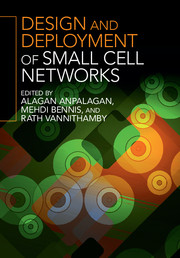Book contents
- Frontmatter
- Contents
- List of contributors
- Preface
- 1 Mobility performance optimization for 3GPP LTE HetNets
- 2 Design and performance analysis of multi-radio small cell networks
- 3 Dynamic TDD small cell management
- 4 3GPP RAN standards for small cells
- 5 Dense networks of small cells
- 6 Traffic offloading scenarios for heterogeneous networks
- 7 Required number of small cell access points in heterogeneous wireless networks
- 8 Small cell deployments: system scenarios, performance, and analysis
- 9 Temporary cognitive small cell networks for rapid and emergency deployments
- 10 Long-term evolution (LTE) and LTE-Advanced activities in small cell networks
- 11 Game theory and learning techniques for self-organization in small cell networks
- 12 Energy efficient strategies with BS sleep mode in green small cell networks
- 13 Mobility management in small cell heterogeneous networks
- 14 The art of deploying small cells: field trial experiments, system design, performance prediction, and deployment feasibility
- 15 Centralized self-optimization of interference management in LTE-A HetNets
- 16 Self-organized ICIC for SCN
- 17 Large-scale deployment and scalability
- 18 Energy efficient heterogeneous networks
- 19 Time- and frequency-domain e-ICIC with single- and multi-flow carrier aggregation in HetNets
- Index
- References
17 - Large-scale deployment and scalability
Published online by Cambridge University Press: 05 December 2015
- Frontmatter
- Contents
- List of contributors
- Preface
- 1 Mobility performance optimization for 3GPP LTE HetNets
- 2 Design and performance analysis of multi-radio small cell networks
- 3 Dynamic TDD small cell management
- 4 3GPP RAN standards for small cells
- 5 Dense networks of small cells
- 6 Traffic offloading scenarios for heterogeneous networks
- 7 Required number of small cell access points in heterogeneous wireless networks
- 8 Small cell deployments: system scenarios, performance, and analysis
- 9 Temporary cognitive small cell networks for rapid and emergency deployments
- 10 Long-term evolution (LTE) and LTE-Advanced activities in small cell networks
- 11 Game theory and learning techniques for self-organization in small cell networks
- 12 Energy efficient strategies with BS sleep mode in green small cell networks
- 13 Mobility management in small cell heterogeneous networks
- 14 The art of deploying small cells: field trial experiments, system design, performance prediction, and deployment feasibility
- 15 Centralized self-optimization of interference management in LTE-A HetNets
- 16 Self-organized ICIC for SCN
- 17 Large-scale deployment and scalability
- 18 Energy efficient heterogeneous networks
- 19 Time- and frequency-domain e-ICIC with single- and multi-flow carrier aggregation in HetNets
- Index
- References
Summary
Introduction
Combined with a technology upgrade to LTE/LTE-A, small cells are presented by many industry players (from operators to equipment vendors to analysts) as the most cost-effective solution to the known increase in mobile data demand [1–3]. As small cells (e.g., femto and pico) become the broadly adopted solution for adding capacity to modern, smart phone-dominated cellular networks, their numbers, and the areas where they will be deployed, will increase dramatically (Figure 17.1).
This reduction in cell size and the growth in cell numbers has required many new approaches to be developed to ensure that the next generation of networks are built to exploit costly, limited spectrum resources while maximizing capacity.
Such new methods consider the network design process in a holistic manner and ensure sufficient computational power is available to remove any accuracy compromises inherent with the traditional design processes. The set of techniques used to accomplish this we call large-scale network design, or L-SND for short.
The US cellular market has many good examples of planned small cell deployments that are to occur at a national level [1]. Results and data from such small cell designs are included in this chapter to illustrate the L-SND accuracy and scalability difficulties that have been overcome when compared to the limitations found with traditional methods.
Large-scale network design
Large-scale network design groups advanced radio-planning algorithms and technical solutions to evaluate vast numbers of sites without overloading engineering resources. Big data, cloud computing, and optimized metaheuristic algorithms are basic parts of the pool of multiple components that have to be combined to solve the small cell challenge.
The methodology described in this chapter has been implemented in Overture and the results shown have been shared by Keima Technologies.
Following model-based control theory [4, 5], L-SND aims to reduce the gap between business-case analysis and deployment. By utilizing the advantages of big data and cloud computing it is possible to seamlessly link marketing, planning, and deployment information. As the analysis evolves, robustness is built into the study by integration of feedback and new or updated big data components to review the objectives. In a real-life scenario, such systems will utilize practical and realistic information to evaluate outcomes and to maximize the advantages of economies of scale through a quicker (but more detailed) design phase.
- Type
- Chapter
- Information
- Design and Deployment of Small Cell Networks , pp. 425 - 461Publisher: Cambridge University PressPrint publication year: 2015



